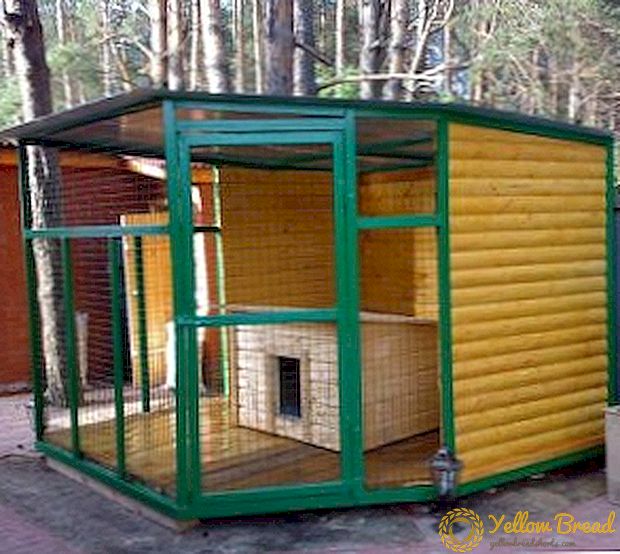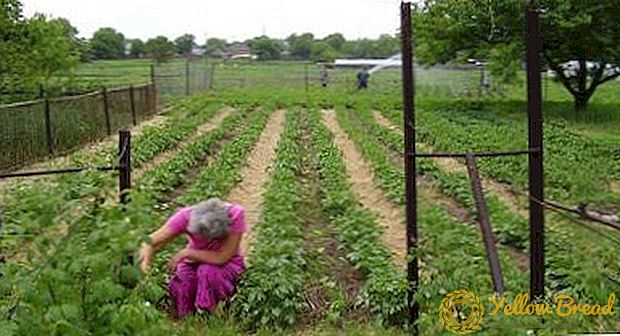 Previously, dogs that lived in the yard, built booths and tied them with a chain. Today, increasingly resorting to the construction of spacious enclosures. On the one hand, the dog does not have access to the body of the guest who enters the courtyard, on the other hand, the collar does not dangle on his neck all the time, and the faithful guard can move to his full height habitat. In this material, we suggest you to get acquainted with the technique of making the correct enclosure for dogs with your own hands.
Previously, dogs that lived in the yard, built booths and tied them with a chain. Today, increasingly resorting to the construction of spacious enclosures. On the one hand, the dog does not have access to the body of the guest who enters the courtyard, on the other hand, the collar does not dangle on his neck all the time, and the faithful guard can move to his full height habitat. In this material, we suggest you to get acquainted with the technique of making the correct enclosure for dogs with your own hands.
- Where to start
- Choose a suitable place
- Calculate area and height
- Draw a drawing
- Selection of materials
- Walls and door
- Roof
- Floor
- What else is important to consider
- The presence of the booth
- Manger
Where to start
First you need to understand the true purpose of the aviary. After all, it should be not only the usual fence for the dog. In the construction of your friend and the guard will spend almost all day. Therefore, all the elements necessary for its normal and comfortable living should be clearly thought out. Namely:
- feeding trough from which the dog will eat;
- a place where he can hide in case of bad weather, cold or sun;
- walking area.
Next, you should decide on the place where the aviary will be equipped, its size. Sizes will be calculated depending on the breed of pet.
Choose a suitable place
The choice of location should also be made in accordance with the priority that the dog should be comfortable. It should not be annoyed by the noise of cars, so if possible you should have a home away from the road. Buildings for other pets should also be located at a distance. Like the places where you join the carpentry or do any other noisy work. Unpleasant smells should also not reach your pet's home, for example, from a toilet or cesspool.
Ideally, the source of irritation should be located 500 m from the open-air cage, for example, in a rural area or on a large summer cottage, and 10-15 m in a private town or country house.
At night, the aviary should be illuminated - this point should also be considered: is it possible with the help of centralized lighting, or can it be the light of his own hand?  The place where it is planned to equip the enclosure should be sheltered from the winds. It should not be somewhere in a remote corner - the dog needs to observe what is happening in the yard and at the entrance.
The place where it is planned to equip the enclosure should be sheltered from the winds. It should not be somewhere in a remote corner - the dog needs to observe what is happening in the yard and at the entrance.
The recommended location of the premises is southeast.
The best place will be in the frontal part near the entrance to the courtyard, on the side of the walkway leading to the house.
Calculate area and height
The area and height of the enclosure is calculated based on the size of the pet. By area, there are certain minimums. One of the sides must be at least 2 m. 
Here are some guidelines for building a dog enclosure and its size:
- For dogs with a height in the withers up to 50 cm, the minimum area of the enclosure should be at least 6 square meters. The dwelling for two dogs or one bitch with children of such dimensions should not be less than 9 square meters. m
- For dogs that are 51–65 cm tall in adulthood, an open-air cage area of 8 square meters is required. m. For two dogs or females with puppies - from 12 square meters. m
- Pets above 66 cm must be kept in an open-air cage with an area of 10 square meters. m. For two dogs or females with puppies need to equip a room the size of 15 square meters. m
The height of the dog "apartment" should be such that the dog could stand up to its full height on its hind legs, without touching the ceiling. By the way, if the pet is still small, and you do not know how it will be in adulthood, you can approximately calculate it, knowing the size of its paws, chest, weight and other parameters. For example, one of the unscientific formulas says that the weight of a puppy in two months should be multiplied by three and add 200 g - this will be the mass of an adult.
Draw a drawing
After the dimensions of the enclosure for dogs with their own hands will be determined, it is necessary to draw a drawing. You can take as a basis ready-made, examples of which can be found on the Internet. Usually enclosures on them consist of lined borders:
- winter road with a booth and without;
- scaffold;
- open area.
Selection of materials
After the drawing is ready, it is necessary to think over and purchase materials for a dog enclosure. Here are a few recommendations on what is best to make walls, doors, roof and floor, so that your pet is cozy and comfortable.
Walls and door
The front wall, which will serve the dog for a review of the courtyard area, must be from the grille. At the same time, it is not recommended to use the net - large four-legged ones can easily carry them with their paws or break their teeth about them.  The best solution is to use round or square metal tubes. They should not be galvanized or powder. It is necessary to cook them with each other qualitatively, especially if your pet has large sizes and large body mass.
The best solution is to use round or square metal tubes. They should not be galvanized or powder. It is necessary to cook them with each other qualitatively, especially if your pet has large sizes and large body mass.
The pitch between the pipes should be 10 cm for large animals and 5 cm for small animals.
Metal structures and connections for the safety of four-legged should be well primed, cleaned from burrs, remove rust and coated with hot-painted enamel.
There is an option to equip the grid without a welding machine. To do this:
- the rods are good to drive into the ground;
- prepare wooden beams, the length of which is equal to the length of the lattice;
- make a notch on the bars at a distance of iron rods;
- insert the notches of the bars into each of the rods;
- fix the corners - in the bars and corners to drill holes and fasten them with bolts.
 The side and back walls of the dog "flat" can be made of wood, but not thinner than 2 cm, slate, metal profile. Wood walls should be treated with decay agents. They are the best for the health of the animal.
The side and back walls of the dog "flat" can be made of wood, but not thinner than 2 cm, slate, metal profile. Wood walls should be treated with decay agents. They are the best for the health of the animal.Roof
Materials such as ondulin, soft tile, decking, etc. are selected for the roof. It is better if it is shingles, since the sediments drumming on it sound least loud and annoying to the animal.
When installing roofing nails should not be used.
Mandatory element should be a visor.
Floor
The floor can be made of concrete or asphalt. Cement is not recommended because it is too cold. On it, your pet will freeze, in addition, there is a risk that he will catch a rheumatic disease.  In any case, it is better to think about the wooden flooring, which is put on an asphalt or concrete floor. They can not cover the entire floor, but only part of it. It will be enough plot of two by two meters.
In any case, it is better to think about the wooden flooring, which is put on an asphalt or concrete floor. They can not cover the entire floor, but only part of it. It will be enough plot of two by two meters.
Also, the concrete base can be insulated with rubble, placing it between the soil and concrete.
It is not necessary to fill the entire floor in the aviary, you can leave a section of soil that is planted with grass. Then your friend will just walk.
The floor should not be made even, as moisture will stagnate on it. It is necessary to build it with a slight slope.
What else is important to consider
After the aviary is ready, it is necessary to tackle its arrangement: make a shed (if it is provided), a feeding trough, entrance doors. The door needs to be made so that it opens in the middle of the enclosure. Heck should be both external and internal.
The presence of the booth
The best shelter for the dog will be the one that is equipped with a booth. It is in it that the animal will spend especially cold periods. 
In its construction, several factors should also be taken into account:
- The booth must clearly correspond to the size of the dog - it must be placed in it in an extended position and have space for a turn. If you make the kennel spacious, it will be cold, it will not be able to keep warm.
- The material for the booth must be exclusively wooden. It is better to choose the construction of coniferous wood.
- If you live in regions where the winters are especially harsh, then the booth should be made with double walls, the space between which should be laid out with insulation.
- The ideal option allowing to clean in the box will be a removable roof.
- It’s better to make the roof flat with a slope - some pets like to use this seating position so that it is more convenient to observe the territory entrusted to it.
- It is strictly prohibited to use the inner lining of the paint booth or varnish for processing.
Manger
The feeder is recommended to be installed at a height of 20-30 cm from the floor.
 It is better to think about the turning mechanism for the feeder and the device for fixing it in the closed position.
It is better to think about the turning mechanism for the feeder and the device for fixing it in the closed position.For the safety of the animal, the feeder must be attached to a blank wall.






